Stars/Sun/Heliometry
< Stars < SunHeliometry is the science of measuring the properties of the Sun.
Astronomy

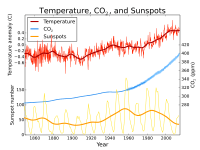
"The color of a star, as determined by the peak frequency of the visible light, depends on the temperature of the star's outer layers, including its photosphere.[1]"[2] The effective temperature of the surface of the Sun's photosphere is 5,778 K.[3] The "[t]emperature at [the] bottom of [the Sun's] photosphere [is] 6600 K", while the "[t]emperature at [the] top of [the] photosphere [is] 4400 K".[3] The photosphere is "~400 km" in thickness.[3]
The peak emittance wavelength of 501.5 nm (~0.5 eV) makes the photosphere a primarily green radiation source. The figure at the right shows the extraterrestrial solar spectral irradiance as compared with a blackbody spectrum. The sharper than black-body cutoff at the shorter wavelength end indicates an even lower likelihood that X-rays are emitted from the photosphere.
Radiation
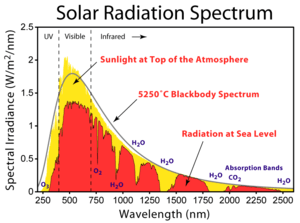
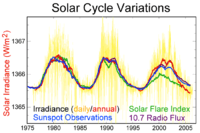
"Direct irradiance measurements have only been available during the last three cycles and are based on a composite of many different observing satellites.[4] [5] However, the correlation between irradiance measurements and other proxies of solar activity make it reasonable to estimate past solar activity. Most important among these proxies is the record of sunspot observations that has been recorded since ~1610. Since sunspots and associated faculae are directly responsible for small changes in the brightness of the sun, they are closely correlated to changes in solar output. Direct measurements of radio emissions from the Sun at 10.7 cm also provide a proxy of solar activity that can be measured from the ground since the Earth's atmosphere is transparent at this wavelength. Lastly, solar flares are a type of solar activity that can impact human life on Earth by affecting electrical systems, especially satellites. Flares usually occur in the presence of sunspots, and hence the two are correlated, but flares themselves make only tiny perturbations of the solar luminosity."[6]
"Solar irradiance and insolation are measures of the amount of sunlight that reaches the Earth. The equipment used might measure optical brightness, total radiation, or radiation in various frequencies."[6]
Electromagnetics
Notation: let the symbol  represent the net solar charge.
represent the net solar charge.
"[A] variety of geophysical and astrophysical phenomena can be explained by a net charge on the Sun of -1.5 x 1028 e.s.u."[7] This figure was later reduced by a factor of five.[8]
Visuals
"The luminosity of stars is measured in two forms: apparent (visible light only) and bolometric (total radiant energy). (A bolometer is an instrument that measures radiant energy over a wide band by absorption and measurement of heating.) When not qualified, "luminosity" means bolometric luminosity, which is measured either in the SI units, watts; or in terms of solar luminosities,  , that is, how many times as much energy the object radiates as the Sun".[9]
, that is, how many times as much energy the object radiates as the Sun".[9]
Notation: let the symbol  represent the solar bolometric luminosity.
represent the solar bolometric luminosity.
"The solar luminosity, [ ], is a unit of radiant flux (power emitted in the form of photons) conventionally used .. to measure the luminosity of stars. One solar luminosity is equal to the current accepted luminosity of the Sun, which is 3.839×1026
], is a unit of radiant flux (power emitted in the form of photons) conventionally used .. to measure the luminosity of stars. One solar luminosity is equal to the current accepted luminosity of the Sun, which is 3.839×1026
W, or 3.839×1033
erg/s.[10] The value is slightly higher, 3.939×1026
W (equivalent to 4.382×109
kg/s or 1.9×10−16
M☉/d) if the solar neutrino radiation is included as well as electromagnetic radiation.[11] The Sun is a weakly variable star and its luminosity therefore fluctuates. The major fluctuation is the eleven-year solar cycle (sunspot cycle), which causes a periodic variation of about ±0.1%. Any other variation over the last 200–300 years is thought to be much smaller than this.[11]"[12]
"The solar luminosity is related to the solar irradiance measured at the Earth or by satellites in Earth orbit. The mean irradiance at the top of the Earth's atmosphere is sometimes known as the solar constant, [ ]. Irradiance is defined as power per unit area, so the solar luminosity (total power emitted by the Sun) is the irradiance received at the Earth (solar constant) multiplied by the area of the sphere whose radius is the mean distance between the Earth and the Sun:
]. Irradiance is defined as power per unit area, so the solar luminosity (total power emitted by the Sun) is the irradiance received at the Earth (solar constant) multiplied by the area of the sphere whose radius is the mean distance between the Earth and the Sun:
where A is the unit distance (the value of the astronomical unit in metres) and k is a constant (whose value is very close to one) that reflects the fact that the mean distance from the Earth to the Sun is not exactly one astronomical unit."[12]
Geography
Notation: let the symbol  indicate the solar radius.
indicate the solar radius.
The "[s]olar radius is a unit of distance used to express the size of stars in astronomy equal to the current radius of the Sun:
The solar radius is approximately 695,500 kilometres (432,450 miles) or about 110 times the radius of the Earth ( ), or 10 times the average radius of Jupiter. It varies slightly from pole to equator due to its rotation, which induces an oblateness of order 10 parts per million."[13]
), or 10 times the average radius of Jupiter. It varies slightly from pole to equator due to its rotation, which induces an oblateness of order 10 parts per million."[13]
Physics
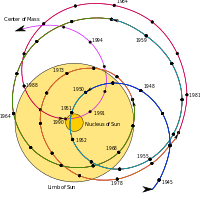
"The center of mass plays an important role in astronomy and astrophysics, where it is commonly referred to as the barycenter. The barycenter is the point between two objects where they balance each other; it is the center of mass where two or more celestial bodies orbit each other. When a moon orbits a planet, or a planet orbits a star, both bodies are actually orbiting around a point that lies away from the center of the primary (larger) body."[14]
"The Sun's motion about the center of mass of the Solar System is complicated by perturbations from the planets. Every few hundred years this motion switches between prograde and retrograde.[15]"[16]
Def. "the mass of the Sun" is called the astronomical unit of mass.[17]
Notation: let the symbol  indicate the solar mass.
indicate the solar mass.
"The solar mass ( ) is a standard unit of mass in astronomy, used to indicate the masses of other stars, as well as clusters, nebulae and galaxies. It is equal to the mass of the Sun, about two nonillion kilograms:"[18]
) is a standard unit of mass in astronomy, used to indicate the masses of other stars, as well as clusters, nebulae and galaxies. It is equal to the mass of the Sun, about two nonillion kilograms:"[18]
"This is about 332,946 times the mass of the Earth or 1,048 times the mass of Jupiter."[18]
"Because the Earth follows an elliptical orbit around the Sun, the solar mass can be computed from the equation for the orbital period of a small body orbiting a central mass.[21] Based upon the length of the year, the distance from the Earth to the Sun (an astronomical unit or AU), and the gravitational constant (G), the mass of the Sun is given by:"[18]
 .
.
"The value of the gravitational constant was derived from 1798 measurements by Henry Cavendish using a torsion balance. The value obtained differed only by about 1% from the modern value.[22] The diurnal parallax of the Sun was accurately measured during the transits of Venus in 1761 and 1769,[23] yielding a value of 9″ (compared to the present 1976 value of 8.794148″). When the value of the diurnal parallax is known, the distance to the Sun can be determined from the geometry of the Earth.[24]"[18]
Technology
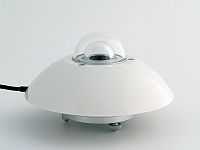
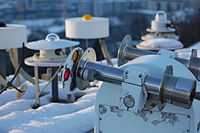
Def. a "device used to measure the heating power of electromagnetic radiation, especially that of solar radiation"[25] is called an actinometer.
Def. an "actinometer used to measure solar radiation incident on a surface"[26] is called a pyranometer.
At right is an SR11 solar radiation sensor. It complies with the "first class" specifications within the latest ISO and WMO standards.
Def. the "total solar radiation from sun and sky on a horizontal surface"[27] is called the global radiation.
The Radiation Observatory, University of Bergen, Bergen, Norway, latitude 60° 24' N and longitude 5° 19' E, at 45 m elevation above sea level, uses one or more pyranometers to measure the Global Radiation.[27]
A sensitivity check is made of each pyranometer against a standard using the sun/shade method on a cloudless day.[27]
A sensitivity may be similar to 4.818 V/Wm-2, which should be a small factor such as 1.0165 times the original sensitivity when first manufactured.[27]
The diffuse (sky) radiation is measured by a pyranometer. "When measuring the sky radiation, the direct solar radiation is constantly shadowed off by means of a 6 cm diameter circular disc mounted on a 30 cm long rotating arm."[27]
Def. a "device that measures the intensity of solar radiation received on the surface of the earth"[28] is called a pyrheliometer.
The normal incidence beam radiation is measured by a normal incidence pyrheliometer with a known and calibrated sensitivity, e.g. 8.15 V/Wm-2.[27]
The pyrheliometer is mounted on an automatic solar tracker.[27]
Def. a "device that measures radiant energy"[29] is called a radiometer.
Ultraviolet radiation is measured by means of a total ultraviolet radiometer with a specific wavelength response such as 290 - 385 nm.[27]
"For the measurement of long-wave radiation, a ventilated [...] pyrgeometer [...] with coated silicon hemisphere [is] used. This makes it possible to compute the [Downward Atmospheric Radiation], since the temperature of the instrument is also recorded."[27]
"The [Duration of Sunshine] is measured by a Campbell-Stoke sunshine recorder with blue paper strips. The strips are read according to the rules of [the World Meteorological Organization] WMO [3]. Maximum possible duration gives the number of hours the sun is above the natural horizon, as found from the records on days with clear skies at sunrise or sunset. The [Duration of Sunshine] is also given as the number of minutes during which the [NIP records] irradiance above 120 Wm-2 (with one instantaneous recording counted as 20 seconds)."[27]
"The necessary routine calibrations of the pyranometers and the NIP pyrheliometer are carried out by means of the absolute self-calibrating cavity pyrheliometer [which in turn is] compared to the World Radiation Reference Scale (WRR)".[27]
Research
Hypothesis:
- The Sun may not be gaseous all the way through.
Control groups

The findings demonstrate a statistically systematic change from the status quo or the control group.
“In the design of experiments, treatments [or special properties or characteristics] are applied to [or observed in] experimental units in the treatment group(s).[30] In comparative experiments, members of the complementary group, the control group, receive either no treatment or a standard treatment.[31]"[32]
Proof of concept
Def. a “short and/or incomplete realization of a certain method or idea to demonstrate its feasibility"[33] is called a proof of concept.
Def. evidence that demonstrates that a concept is possible is called proof of concept.
The proof-of-concept structure consists of
- background,
- procedures,
- findings, and
- interpretation.[34]
Proof of technology
"[T]he objective of a proof of technology is to determine the solution to some technical problem, such as how two systems might be integrated or that a certain throughput can be achieved with a given configuration."[35]
Def.
- "[a]n original object or form which is a basis for other objects, forms, or for its models and generalizations",[36]
- "[a]n early sample or model built to test a concept or process",[36] or
- "[a]n instance of a category or a concept that combines its most representative attributes"[36] is called a prototype.
Def. "[t]o test something using the conditions that it was designed to operate under, especially out in the real world instead of in a laboratory or workshop"[37] is called "field-test", or a field test.
A "proof-of-technology prototype ... typically implements one critical scenario to exercise or stress the highest-priority requirements."[38]
"[A] proof-of-technology test demonstrates the system can be used"[39].
"The strongest proof of technology performance is based on consistency among multiple lines of evidence, all pointing to similar levels of risk reduction."[40]
See also
References
- ↑ "The Colour of Stars". Australian Telescope Outreach and Education. Retrieved 2006-08-13.
- ↑ "Star, In: Wikipedia". San Francisco, California: Wikimedia Foundation, Inc. June 15, 2012. Retrieved 2012-07-06.
- 1 2 3 David R. Williams (September 2004). "Sun Fact Sheet". Greenbelt, MD: NASA Goddard Space Flight Center. Retrieved 2011-12-20.
- ↑ Active Cavity Radiometer Irradiance Monitor (ACRIM) solar irradiance monitoring 1978 to present (Satellite observations of total solar irradiance); access date 2012-02-03
- ↑ http://www.pmodwrc.ch/pmod.php?topic=tsi/composite/SolarConstant
- 1 2 "Solar variation, In: Wikipedia". San Francisco, California: Wikimedia Foundation, Inc. November 17, 2012. Retrieved 2012-11-23.
- ↑ Ludwig Oster & Kenelm W. Philip (January 1961). "Existence of Net Electric Charges on Stars". Nature 189 (4758): 43. doi:10.1038/189043a0.
- ↑ V. A. Bailey (January 1961). "Existence of Net Electric Charges on Stars". Nature 189 (4758): 43-4. doi:10.1038/189043b0.
- ↑ "Luminosity, In: Wikipedia". San Francisco, California: Wikimedia Foundation, Inc. November 17, 2012. Retrieved 2012-11-23.
- ↑ Carroll, Bradley W.; Ostlie, Dale A. (2007). An Introduction to Modern Astrophysics. Pearson Addison-Wesley. pp. Appendix A. ISBN 0-8053-0402-9.
- 1 2 Noerdlinger, Peter D. (2008). "Solar Mass Loss, the Astronomical Unit, and the Scale of the Solar System". Celest. Mech. Dynam. Astron. 0801: 3807.
- 1 2 "Solar luminosity, In: Wikipedia". San Francisco, California: Wikimedia Foundation, Inc. October 23, 2012. Retrieved 2012-11-23.
- ↑ "Solar radius, In: Wikipedia". San Francisco, California: Wikimedia Foundation, Inc. May 9, 2012. Retrieved 2012-07-05.
- ↑ "Center of mass, In: Wikipedia". San Francisco, California: Wikimedia Foundation, Inc. November 12, 2012. Retrieved 2012-11-20.
- ↑ Javaraiah (2005). "Sun's retrograde motion and violation of even-odd cycle rule in sunspot activity". Monthly Notices of the Royal Astronomical Society 362 (4): 1311–8. doi:10.1111/j.1365-2966.2005.09403.x.
- ↑ "Sun, In: Wikipedia". San Francisco, California: Wikimedia Foundation, Inc. November 18, 2012. Retrieved 2012-11-20.
- ↑ P. K. Seidelmann (1976). "Measuring the Universe The IAU and astronomical units". International Astronomical Union. Retrieved 2011-11-27.
- 1 2 3 4 "Solar mass, In: Wikipedia". San Francisco, California: Wikimedia Foundation, Inc. September 17, 2012. Retrieved 2012-11-23.
- ↑ 2013 Astronomical Constants http://asa.usno.navy.mil/SecK/2013/Astronomical_Constants_2013.pdf
- ↑ NIST CODATA http://physics.nist.gov/cgi-bin/cuu/Value?bg
- ↑ Harwit, Martin (1998), Astrophysical concepts (3 ed.), Springer, ISBN 0-387-94943-7, http://books.google.com/books?id=trAAgqWZVlkC&pg=PA72
- ↑ Holton, Gerald James; Brush, Stephen G. (2001). Physics, the human adventure: from Copernicus to Einstein and beyond (3rd ed.). Rutgers University Press. p. 137. ISBN 0-8135-2908-5.
- ↑ Pecker, Jean Claude; Kaufman, Susan (2001). Understanding the heavens: thirty centuries of astronomical ideas from ancient thinking to modern cosmology. Springer. pp. 291–291. ISBN 3-540-63198-4.
- ↑ Barbieri, Cesare (2007). Fundamentals of astronomy. CRC Press. pp. 132–140. ISBN 0-7503-0886-9.
- ↑ "actinometer, In: Wiktionary". San Francisco, California: Wikimedia Foundation, Inc. October 8, 2013. Retrieved 2013-10-28.
- ↑ "pyranometer, In: Wiktionary". San Francisco, California: Wikimedia Foundation, Inc. March 4, 2013. Retrieved 2013-10-28.
- 1 2 3 4 5 6 7 8 9 10 11 Jan Asle Olseth, Arvid Skartveit, Frank Cleveland, Tor de Lange, Tor-Villy Kangas (2004). Radiation Yearbook No. 39. Bergen, Norway: Geophysical Institute, University of Bergen. pp. 78. http://web.gfi.uib.no/forskning/Taarnet/2003yb.pdf. Retrieved 2013-10-28.
- ↑ "pyrheliometer, In: Wiktionary". San Francisco, California: Wikimedia Foundation, Inc. October 7, 2013. Retrieved 2013-10-28.
- ↑ "radiometer, In: Wiktionary". San Francisco, California: Wikimedia Foundation, Inc. October 8, 2013. Retrieved 2013-10-28.
- ↑ Klaus Hinkelmann, Oscar Kempthorne (2008). Design and Analysis of Experiments, Volume I: Introduction to Experimental Design (2nd ed.). Wiley. ISBN 978-0-471-72756-9. http://books.google.com/?id=T3wWj2kVYZgC&printsec=frontcover.
- ↑ R. A. Bailey (2008). Design of comparative experiments. Cambridge University Press. ISBN 978-0-521-68357-9. http://www.cambridge.org/uk/catalogue/catalogue.asp?isbn=9780521683579.
- ↑ "Treatment and control groups, In: Wikipedia". San Francisco, California: Wikimedia Foundation, Inc. May 18, 2012. Retrieved 2012-05-31.
- ↑ "proof of concept, In: Wiktionary". San Francisco, California: Wikimedia Foundation, Inc. November 10, 2012. Retrieved 2013-01-13.
- ↑ Ginger Lehrman and Ian B Hogue, Sarah Palmer, Cheryl Jennings, Celsa A Spina, Ann Wiegand, Alan L Landay, Robert W Coombs, Douglas D Richman, John W Mellors, John M Coffin, Ronald J Bosch, David M Margolis (August 13, 2005). "Depletion of latent HIV-1 infection in vivo: a proof-of-concept study". Lancet 366 (9485): 549-55. doi:10.1016/S0140-6736(05)67098-5. http://www.ncbi.nlm.nih.gov/pmc/articles/PMC1894952/. Retrieved 2012-05-09.
- ↑ "Proof of concept, In: Wikipedia". San Francisco, California: Wikimedia Foundation, Inc. December 27, 2012. Retrieved 2013-01-13.
- 1 2 3 "prototype, In: Wiktionary". San Francisco, California: Wikimedia Foundation, Inc. December 8, 2013. Retrieved 2014-01-03.
- ↑ "field-test, In: Wiktionary". San Francisco, California: Wikimedia Foundation, Inc. August 5, 2012. Retrieved 2013-01-13.
- ↑ A. Liu; I. Gorton (March/April 2003). "Accelerating COTS middleware acquisition: the i-Mate process". Software, IEEE 20 (2): 72-9. doi:10.1109/MS.2003.1184171. http://cin.ufpe.br/~redis/intranet/bibliography/middleware/liu-cots03.pdf. Retrieved 2012-02-15.
- ↑ Rhea Wessel (January 25, 2008). "Cargo-Tracking System Combines RFID, Sensors, GSM and Satellite". RFID Journal: 1-2. http://www.rfidjournal.com/article/pdf/3870/1/1/rfidjournal-article3870.PDF. Retrieved 2012-02-15.
- ↑ P. Suresh, C. Rao, M.D. Annable and J.W. Jawitz (August 2000). E. Timothy Oppelt. ed. [http://www.afcee.af.mil/shared/media/document/AFD-071003-081.pdf#page=108 In Situ Flushing for Enhanced NAPL Site Remediation: Metrics for Performance Assessment, In: Abiotic In Situ Technologies for Groundwater Remediation Conference]. Cincinnati, Ohio: U.S. Environmental Protection Agency. pp. 105. http://www.afcee.af.mil/shared/media/document/AFD-071003-081.pdf#page=108. Retrieved 2012-02-15.
External links
- African Journals Online
- Bing Advanced search
- Google Books
- Google scholar Advanced Scholar Search
- International Astronomical Union
- JSTOR
- Lycos search
- NASA/IPAC Extragalactic Database - NED
- NASA's National Space Science Data Center
- NCBI All Databases Search
- NCBI Site Search
- Office of Scientific & Technical Information
- PubChem Public Chemical Database
- Questia - The Online Library of Books and Journals
- SAGE journals online
- The SAO/NASA Astrophysics Data System
- Scirus for scientific information only advanced search
- SDSS Quick Look tool: SkyServer
- SIMBAD Astronomical Database
- SIMBAD Web interface, Harvard alternate
- Spacecraft Query at NASA.
- SpringerLink
- Taylor & Francis Online
- Universal coordinate converter
- Wiley Online Library Advanced Search
- Yahoo Advanced Web Search
| ||||||||||||||||||||||||||||||||
| |||||||||||||||||||||||||||||||||||||||||
![]() This is a research project at http://en.wikiversity.org
This is a research project at http://en.wikiversity.org
| |
Development status: this resource is experimental in nature. |
| |
Educational level: this is a research resource. |
| |
Resource type: this resource is an article. |
| |
Resource type: this resource contains a lecture or lecture notes. |
| |
Subject classification: this is an astronomy resource. |



